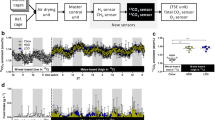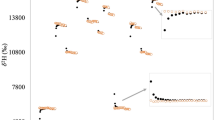Abstract
Indirect calorimetry is increasingly used to investigate why compounds or genetic manipulations affect body weight or composition in small animals. This review introduces the principles of indirect (primarily open-circuit) calorimetry and explains some common misunderstandings. It is not widely understood that in open-circuit systems in which carbon dioxide (CO2) is not removed from the air leaving the respiratory chamber, measurement of airflow out of the chamber and its oxygen (O2) content paradoxically allows a more reliable estimate of energy expenditure (EE) than of O2 consumption. If the CO2 content of the exiting air is also measured, both O2 consumption and CO2 production, and hence respiratory quotient (RQ), can be calculated. Respiratory quotient coupled with nitrogen excretion allows the calculation of the relative combustion of the macronutrients only if measurements are over a period where interconversions of macronutrients that alter their pool sizes can be ignored. Changes in rates of O2 consumption and CO2 production are not instantly reflected in changes in the concentrations of O2 and CO2 in the air leaving the respiratory chamber. Consequently, unless air-flow is high and chamber size is small, or rates of change of O2 and CO2 concentrations are included in the calculations, maxima and minima are underestimated and will appear later than their real times. It is widely appreciated that bigger animals with more body tissue will expend more energy than smaller animals. A major issue is how to compare animals correcting for such differences in body size. Comparison of the EE or O2 consumption per gram body weight of lean and obese animals is misleading because tissues vary in their energy requirements or in how they influence EE in other ways. Moreover, the contribution of fat to EE is lower than that of lean tissue. Use of metabolic mass for normalisation, based on interspecific scaling exponents (0.75 or 0.66), is similarly flawed. It is best to use analysis of covariance to determine the relationship of EE to body mass or fat-free mass within each group, and then test whether this relationship differs between groups.
This is a preview of subscription content, access via your institution
Access options
Subscribe to this journal
Receive 12 print issues and online access
$259.00 per year
only $21.58 per issue
Buy this article
- Purchase on Springer Link
- Instant access to full article PDF
Prices may be subject to local taxes which are calculated during checkout




Similar content being viewed by others
References
Weir JB . New methods for calculating metabolic rate with special reference to protein metabolism. J Physiol 1949; 109: 1–9.
Even PC, Mokhtarian A, Pele A . Practical aspects of indirect calorimetry in laboratory animals. Neurosci Biobehav Rev 1994; 18: 435–447.
Jequier E, Felber JP . Indirect calorimetry. Baillieres Clin Endocrinol Metab 1987; 1: 911–935.
Ferrannini E . The theoretical bases of indirect calorimetry: a review. Metabolism 1988; 37: 287–301.
Ravussin E, Lillioja S, Anderson TE, Christin L, Bogardus C . Determinants of 24-h energy expenditure in man. Methods and results using a respiratory chamber. J Clin Invest 1986; 78: 1568–1578.
Simonson DC, DeFronzo RA . Indirect calorimetry: methodological and interpretative problems. Am J Physiol 1990; 258: E399–E412.
McArdle WD, Katch FI, Katch VL . Exercise Physiology: Energy Nutrition and Human Performance. Lippincott Williams & Wilkins: Baltimore, 2001.
Slonim NB, Bender NR . Environmental Physiology. CV Mosby Co.: St Louis, 1974.
Koteja P . Measuring energy expenditure metabolism with open-flow respirometric systems: which design to choose. Funct Ecol 1996; 10: 675–677.
Speakman JR . The cost of living: field metabolic rates of small mammals. Adv Ecol Res 2000; 30: 177–297.
Stocker C, O'Dowd J, Morton NM, Wargent E, Sennitt MV, Hislop D et al. Modulation of susceptibility to weight gain and insulin resistance in low birthweight rats by treatment of their mothers with leptin during pregnancy and lactation. Int J Obes Relat Metab Disord 2004; 28: 129–136.
Stock MJ . Gluttony and thermogenesis revisited. Int J Obes Relat Metab Disord 1999; 23: 1105–1117.
Jackson DM, Trayhurn P, Speakman JR . Associations between energetics and over-winter survival in the short-tailed field vole Microtus agrestis. J Anim Ecol 2001; 70: 633–640.
Rubner M . Uber den Einfluss der Körpergrosse auf Stöff- und Kraftwechsel. Z Fur Biol 1883; 19: 535–562.
Himms-Hagen J . On raising energy expenditure in ob/ob mice. Science 1997; 276: 1132–1133.
Kleiber M . Body size and metabolism. Hilgardia 1932; 6: 315–353.
West GB, Brown JH, Enquist BJ . The fourth dimension of life: fractal geometry and allometric scaling of organisms. Science 1999; 284: 1677–1679.
White CR, Seymour RS . Mammalian basal metabolic rate is proportional to body mass2/3. Proc Natl Acad Sci USA 2003; 100: 4046–4049.
Kozlowski J, Konarzewski M . Is West, Brown and Enquist's model of allometric scaling mathematically correct and biologically relevant? Funct Ecol 2004; 18: 283–289.
Kozlowski J, Konarzewski M, Gawelczyk AT . Cell size as a link between noncoding DNA and metabolic rate scaling. Proc Natl Acad Sci USA 2003; 100: 14080–14085.
Weibel ER, Hoppeler H . Exercise-induced maximal metabolic rate scales with muscle aerobic capacity. J Exp Biol 2005; 208: 1635–1644.
Elia M . Organ and tissue contributions to metabolic rate. In: Kinney JM,Tucker HN (eds). Energy Metabolism: Tissue Determinants and Cellular Corollaries. Raven: New York, 1992.
Speakman JR . Body Composition Analysis in Animals: A Handbook of Non-Destructive Methods. Cambridge University Press: Cambridge, UK, 2001.
Selman C, Lumsden S, Bunger L, Hill WG, Speakman JR . Resting metabolic rate and morphology in mice (Mus musculus) selected for high and low food intake. J Exp Biol 2001; 204: 777–784.
Speakman JR, Johnson MS . Relationships between resting metabolic rate and morphology in lactating mice: what tissues are the major contributors to resting metabolism?. In: Heldmaier G, Klingenspor M (eds). Life in the Cold. Springer: Berlin, 2000.
Garrow JS, Webster J . Are pre-obese people energy thrifty? Lancet 1985; 1: 670–671.
Nelson KM, Weinsier RL, Long CL, Schutz Y . Prediction of resting energy expenditure from fat-free mass and fat mass. Am J Clin Nutr 1992; 56: 848–856.
Bitz C, Toubro S, Larsen TM, Harder H, Rennie KL, Jebb SA et al. Increased 24-h energy expenditure in type 2 diabetes. Diabetes Care 2004; 27: 2416–2421.
Wang Z, Heshka S, Gallagher D, Boozer CN, Kotler DP, Heymsfield SB . Resting energy expenditure-fat-free mass relationship: new insights provided by body composition modeling. Am J Physiol Endocrinol Metab 2000; 279: E539–E545.
Heymsfield SB, Gallagher D, Kotler DP, Wang Z, Allison DB, Heshka S . Body-size dependence of resting energy expenditure can be attributed to nonenergetic homogeneity of fat-free mass. Am J Physiol Endocrinol Metab 2002; 282: E132–E138.
Packard GC, Boardman TJ . The misuse of ratios, indices, and percentages in ecophysiological research. Physiol Zool 1988; 61: 1–9.
Packard GC, Boardman TJ . The use of percentages and size-specific indices to normalise physiological data for variation in body size: wasted time wasted effort? Comp Biochem Physiol A 1999; 122: 37–44.
White CR . Allometric analysis beyond heterogeneous regression slopes: use of the Johnson–Neyman technique in comparative biology. Physiol Biochem Zool 2003; 76: 1509–1518.
MacLean PS, Higgins JA, Johnson GC, Fleming-Elder BK, Donahoo WT, Melanson EL et al. Enhanced metabolic efficiency contributes to weight regain after weight loss in obesity-prone rats. Am J Physiol Regul Integr Comp Physiol 2004; 287: R1306–R1315.
Meyer CW, Klingenspor M, Rozman J, Heldmaier G . Gene or size: metabolic rate and body temperature in obese growth hormone-deficient dwarf mice. Obes Res 2004; 12: 1509–1518.
Prentice AM, Black AE, Coward WA, Davies HL, Goldberg GR, Murgatroyd PR et al. High levels of energy expenditure in obese women. BMJ (Clin Res Ed) 1986; 292: 983–987.
Jebb SA . The nutrition society medical lecture. Obesity: from molecules to man. Proc Nutr Soc 1999; 58: 1–14.
Arch JR . Lessons in obesity from transgenic animals. J Endocrinol Invest 2002; 25: 867–875.
Acknowledgements
We acknowledge the support of Mike Cawthorne, who first introduced JA to indirect calorimetry and provided advice on the manuscript.
Author information
Authors and Affiliations
Corresponding author
Rights and permissions
About this article
Cite this article
Arch, J., Hislop, D., Wang, S. et al. Some mathematical and technical issues in the measurement and interpretation of open-circuit indirect calorimetry in small animals. Int J Obes 30, 1322–1331 (2006). https://doi.org/10.1038/sj.ijo.0803280
Received:
Revised:
Accepted:
Published:
Issue Date:
DOI: https://doi.org/10.1038/sj.ijo.0803280
Keywords
This article is cited by
-
A long-term obesogenic high-fat diet in mice partially dampens the anti-frailty benefits of late-life intermittent fasting
GeroScience (2023)
-
Adropin correlates with aging-related neuropathology in humans and improves cognitive function in aging mice
npj Aging and Mechanisms of Disease (2021)
-
Severe protein deficiency induces hepatic expression and systemic level of FGF21 but inhibits its hypothalamic expression in growing rats
Scientific Reports (2021)
-
Late-life intermittent fasting decreases aging-related frailty and increases renal hydrogen sulfide production in a sexually dimorphic manner
GeroScience (2021)
-
A comparison of the metabolic effects of sustained strenuous activity in polar environments on men and women
Scientific Reports (2020)



